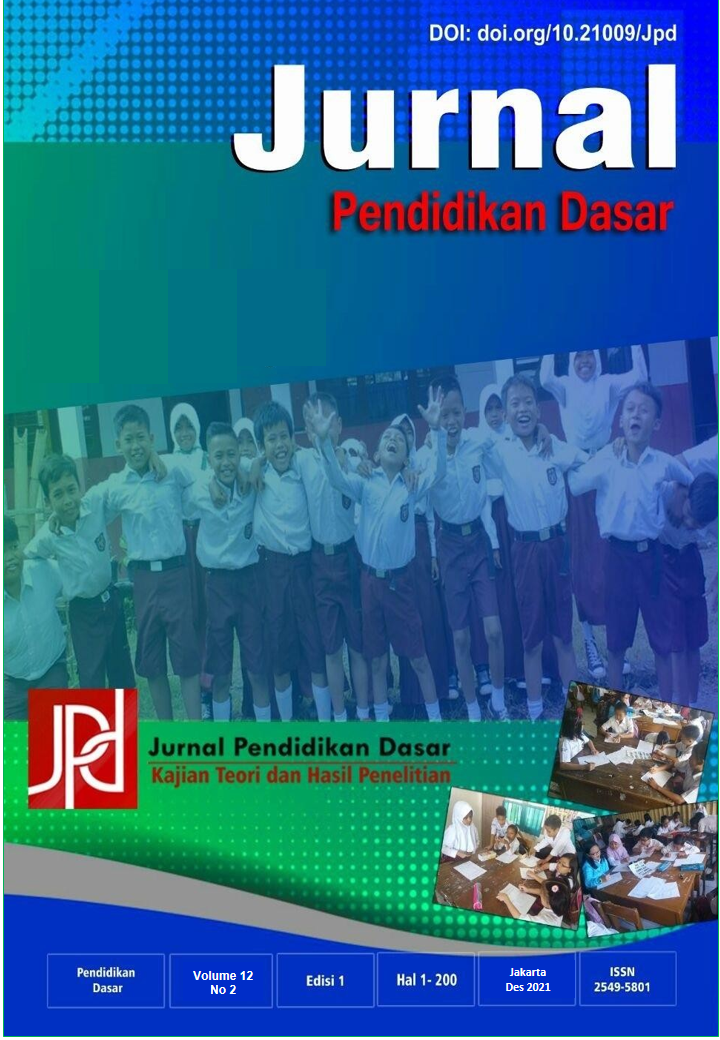PENDIDIKAN MULTIKULTURAL DI SEKOLAH DASAR : EKSPLORASI BATIK NUSANTARA BERBASIS KEARIFAN LOKAL
DOI:
https://doi.org/10.21009/jpd.v12i02.26790Keywords:
education, multicultural, local wisdom, batikAbstract
The purpose of this research is to explore the local batik Nusantara area at the level of primary school education as the initial foundation of multicultural attitude planting through formal education integrated into learning activities. Indonesia is a multicultural country with a variety of tribes, cultures, customs, languages, and religions. With such diversity, we must tie with a sense of nationalism over the ownership of the Unitary State of the Republic of Indonesia. Facing these multicultural realities, of course, the educational process must be able to optimize integrating force in the midst of the current life of globalization. However, educators and education in Indonesia, related to multicultural matters are considered as culturally sensitive. One of the efforts that can be made to improve the understanding of multiculturalism is to develop a medium that can be used as an integrating force in the life of the Indonesian nation. The most possible medium for this is batik. Batik was chosen as a media integrating force because bati has many symbols that are closely related to the local wisdom, nature, and history typical of every region in the archipelago
References
Eny Kustiyah, I. (2017). Batik Sebagai Identitas Kultural Bangsa Indonesia Di Era Globalisasi. Gema.
Ibrahim, H., & Yusdi, M. (2019). The Tomb of Teungku Di Anjong: From History, Art Artifacts and Revitalization Motive for the Development of Aceh Creative Batik Design. Paramita: Historical Studies Journal, 29(2), 204–212. https://doi.org/10.15294/paramita.v29i2.18888
Junifer, C. (2016). Brightspot Market sebagai Representasi Identitas “Cool” Kaum Muda Jakarta. MASYARAKAT: Jurnal Sosiologi, 21(1), 109–131. https://doi.org/10.7454/mjs.v21i1.4637
Lee, S. J., Jahng, K. E., & Kim, K. (2020). Light and shade of multicultural education in South Korea: Analysis through Bourdieu’s concept of capital. Journal for Multicultural Education, 14(2), 149–161. https://doi.org/10.1108/JME-11-2019-0081
Maziyah, S., Mahirta, M., & Atmosudiro, S. (2016). Makna Simbolis Batik Pada Masyarakat Jawa Kuna. Paramita: Historical Studies Journal, 26(1), 23. https://doi.org/10.15294/paramita.v26i1.5143
Mursyid. (2015a). Multikulturalisme Di Pesantren: Potret Pendidikan Islam Multikultural. At-Turāṡ, 2(2), 164.
Mursyid, H. (2015b). Membentuk Wawasan Kebangsaan Santri: Studi Kasus di Pondok Pesantren Nurul Jadid Paiton Probolinggo. Jurnal Kependidikan, 7(2), 265–282.
Okoye-Johnson, O. (2011). Does multicultural education improve students’ racial attitudes? Implications for closing the achievement gap. Journal of Black Studies, 42(8), 1252–1274. https://doi.org/10.1177/0021934711408901
Puspita, Y. (2018). Pentingnya Pendidikan Multikultural. Seminar Nasional Pendidikan Universitas PGRI Palembang, 285–291. https://doi.org/10.1017/CBO9781107415324.004
Rosyada, D. (2014). Pendidikan multikultural di indonesia sebuah pandangan konsepsional. Sosio didaktika: Social Science Education Journal. https://doi.org/10.15408/sd.v1i1.1200
Steelyana, E. (2012). Batik, A Beautiful Cultural Heritage that Preserve Culture and Supporteconomic Development in Indonesia. Binus Business Review, 3(1), 116. https://doi.org/10.21512/bbr.v3i1.1288
Suharsono, S. (2017). Pendidikan Multikultural. EDUSIANA: Jurnal Manajemen Dan Pendidikan Islam, 4(1), 13–23. https://doi.org/10.30957/edusiana.v4i1.3
Supriatin, A., & Nasution, A. R. (2017). Implementasi Pendidikan Multikultural Dalam Praktik Pendidikan Di Indonesia. Elementary: Jurnal Ilmiah Pendidikan Dasar, 3(1), 1. https://doi.org/10.32332/elementary.v3i1.785
Malihah, E. dan Effendi, R. (2014). Pendidikan Lingkungan Sosial Budaya dan Teknologi. Bandung: Maulana Media Grafika.
Ardiwinata, J. dan Hufad, A. (2009). Sosiologi Antropologi Pendidikan. Bandung: UPI PRESS.
Setiawati, E., Abdullan, I., & Lasiyo. (2011). Strategi Pengembangan Komoditas Studi Tentang Budaya Ekonomi di Kalangan Pengusaha Batik Laweyan. KAWISTARA, 1(3), 213–320. https://doi.org/10.1017/CBO9781107415324.004
Triana, N. N., & Retnosary, R. (2020). Pengembangan Model Pemasaran Batik Karawang Sebagai Produk Unggulan Daerah. Jurnal Inovasi Dan Pengelolaan Laboratorium, 2(1), 21–27.
Aditya, D. F. (2014). Fashion and Fashion Education Journal. Fashion and Fashion Education Journal, 3(1), 27–33.
Koentjaraningrat. (2007). Manusia dan Kebudayaan di Indonesia. Jakarta: Djambatan
H.A.R. Tilaar. (2002). Pendidikan Kebudayaan dan Masyarakat Madani Indonesia. Bandung: Remaja Rosdakarya.
Downloads
Published
How to Cite
Issue
Section
License
Jurnal Pendidikan Dasar





















